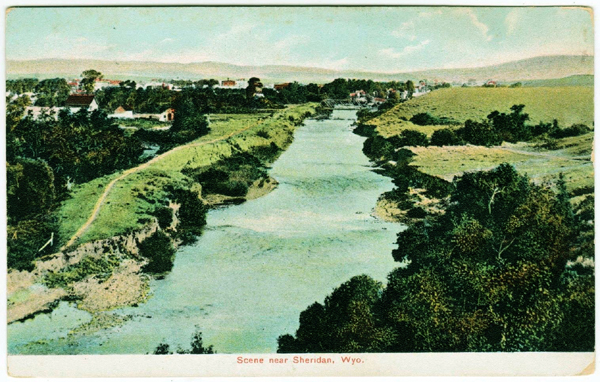
Sheridan, circa 1910. Creek in foreground.
With the arrival of the railroad in 1892,
Sheridan became the scene of rapid growth. By 1893,The area became a
center for coal mining Prior to his development of Cody, Buffalo Bill escorted hunting parties in the
Big Horns. By 1900, it had a population of
over 1500. With the development of the Dome Lake Club and Henry Coffeen's development of
Absaraka Park along the Big Goose, the area attracted sportmen.
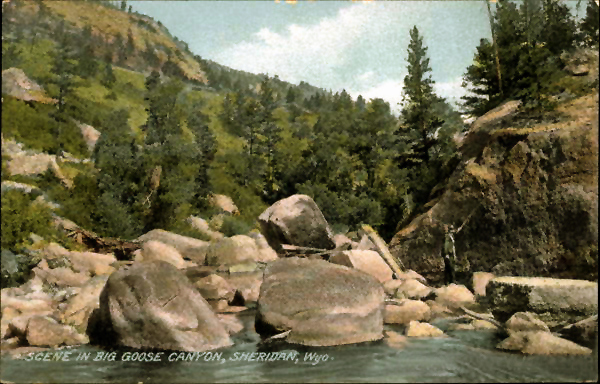
Fishing in Big Goose Canyon, appprox. 1910.
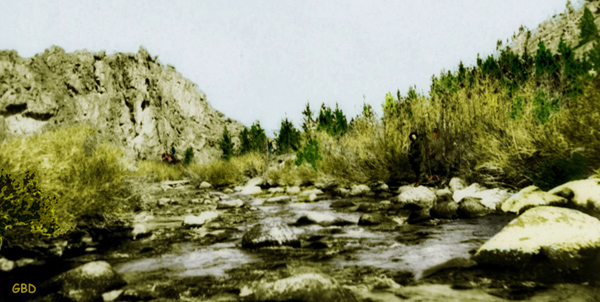
Fishing upper Absaraka Park along the Big Goose, appprox. 1910.
In the above image, there are three persons fishing and one horse and rider
in the image. Can you spot them? If not, see click here
.
By 1910 Sheridan had a population of approximately 12,000. The area was the headquarters for the
OW Ranch which was moved to the area by John Kenrick from Old Woman Creek in present day
Niobrara County. Nearby, Malcolm and William
Moncreiffe, established a ranch which provided horses for Lord Roberts' forces
during the Boer War.
In the early 1890's,two British army officers, Captains George Stockwell (1870-1901) and Francis "Frank" de la Garde Grissell (1842-1923), both of whom had seen service in
India, introduced polo to the area. Captain Grissell was financially well off. His commission was by purchase, a system established to ensure that
officers in the cavalry and infantry had outside income sufficient to restrain corruption. The purchase was in essence a bond
to ensure honesty and was forfeit if the officer was cashiered for incompetency or dishonesty. Grissell
established the famed IXL Ranch on the Tongue River.
The Brand IXL stood for the 9th Lancers [in India sometimes referred to as the "Delhi Spearmen"]
in which Grissell had served. In 1870, The 9th Lancers with the 10th Hussars introduced polo to England with a match
at Houslow Heath. H.R.H. Arthur, Prince of Wales, was in attendance. A centennial commemoration of that initial game
was played at the Great Park, Windsor. Grissell was on that initial team playing for the 9th Lancers. A contemporanious account of the
game later reprinted as a part of Gissell's obituary in Adelaide [South Australia] Register, 2 August 1923, noted:
At the end of the prescribed time the Hussars
had gained 3 goals to 2 gained by the Lancers,
and. through the general remarks made it evident that the new game is most fitted for
cavalry officers. It was admitted by all who were looking that it was more remarkable by the strenth
of the language used by the
players than for anything else.
Later the game begame became more prim and proper. Ladies were admitted to the International Gun and
Polo club, where Gissell sometimes
competed, only on vouchers from their escorts. The rules provided, "Should any Member
furnish vouchers to ladies not received in general society he will be explelled from the club.

The IXL at Dayton, undaed.
Captain George Stockwell was born in Shimla, the British summer capital of India.
His mother was also born in India.
He was one of many Stockwells to see service in India. Based on Army lists and
census information, it is believed that his father was Major John William Inglis Stockwell who saw duty with the 95th (Derbyshire) Regiment both before Sebastopol in the Crimean War as well as in the
Central India Campaign arising out of the Sepoy Mutiny. Captain George Stockwell had attended Wellington and graduated from the
Royal Military Acadamy at Sandhurst. In Wyoming, Captain Stockwell with his brother
Andrew established a small cattle and horse ranch operation on the Big Goose near Beckton, purchasing land
from George Beck. Unfortunately the livestock operation was a financial disaster. He took employment with a copper mining
operation. The copper excitement along the Big Goose ended in the 1890's.
In January 1901, Captain Stockwell had been drinking and exhibited somewhat bizarre behavior. On January 5, he took his rifle and
discharged it upward into his head. Based on his age and shortness of service in the military, it may be speculated that he was a "remitance man."
George Beck believed that George's father had been in the Charge of the light Brigade. It was probably confusion on Beck's part with
a famous advance and retreat led by Major (then Captain) John Wm. Inglis Stockwell during the Central India Campaign at the
Battle of Katah-Ki-Serai. See Raines, Geneal Sir Julius: "The 95th (The Derbyshire) Regiment in central India," Swan Sonnenschein & Co., London, 1900, pp 32,33.
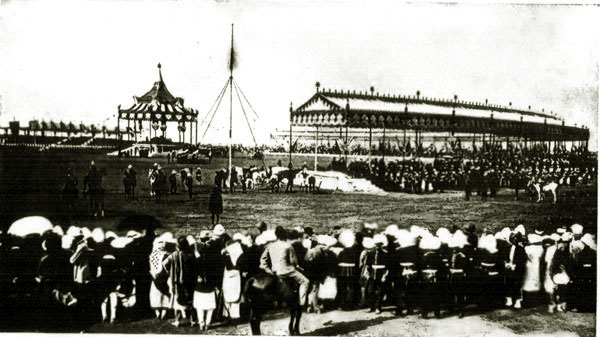
The Great Delhi Durbar, 1877.
Polo clubs were formed in Sheridan, Beckton and and
Big Horn. In 1894, Stockwell broke his collarbone from injuries sustained while playing
polo at the Sheridan Fair Grounds. The injuries did not restrain his enthusiasm for polo. In 1895,
he was the Secretary of Sheridan County Polo Association.
Polo is one of the more dangerus sports. Whilst playing a "chance" game on Christmas Day, 1876,
in celeration of the Delhi Durbar one of Grissell's
fellow officers, Captain William Clayton Clayton, sustained mortal injuries in a collision with a
horse riden by Lord William Beresford. Grissell
sat with his teammate at his death bed and personally affixed the lid on the coffin. Captain Clayton was interred in a graveyard
behind the ridge held by the British during the Mutiny. It was there that those of his fellow
9th Lancers killed in the Mutiny were interred. In addition to Grissell, Lord Beresford and
Captain Clayton had played for the 9th Lancers in the initial game against
the 10th Hassars. The Delhi Dunbar, January 1, 1877, was in celebration of
designation of Queen Victoria as Empress of India.
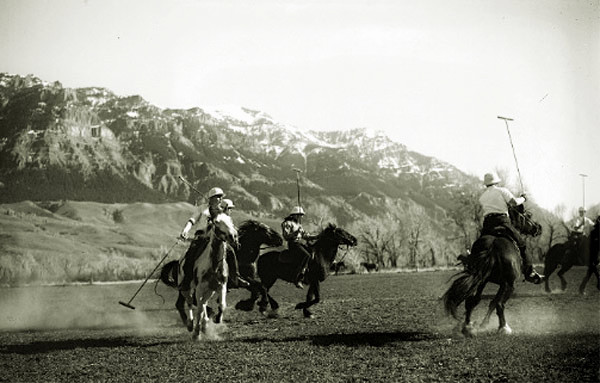
Polo at Big Horn, 1930's. Photo by C. J. Belden.
The sport remains
dangerous. Certainly careening about a polo pitch on a horse at speeds nearly 65 km/hr with a saddle only slightly larger than
a postage stamp; the danger of bing hit by balls and mallets: colliding with other horses; falling and doing
"headers" cannot be regarded as "safe." Indeed, the only time the writer alit from a horse in a less than
decorous manner was from a
European saddle, not on a Western saddle to which the writer was accustomed. The writer landed in some cheval merde.
A voice with a German accent called out, "Sir, are you hurt." The only thing that was hurt was the
writer's dignity.
It has been suggested that the popularity of polo in the east in the late
19th and early 20th century was to provide proof that the elite of the time were not wimps.
Theodore
Roosevelt, a founder of the Oyster Bay Polo club, in his Autobiography suggested a different explanation.
It was an exercise to keep one's self "in as good physical trim as his brethren who do manual labor."
An illustration of the dangerous nature of polo was that of Foxhall Keene who twice was hauled
out of polo games believed to be at death's door from his injuries. He also sustained numerous
broken bones, concussions, etc. See Sports Illustrated, February 23, 1959, The Fabulous World of Foxhall Keene."
The danger continues. In 2014, nine-times U.S. open winner, five-times Player of the year Carlos Gracida died from injuries sustained in the
game. Gracida was ranked as a 10-goal player. Seven years before a member of the Flying H Polo Club from Big Horn,
Skeeter Johnson, died of injuries
sustained in a game in Florida. The Fying H is one of two teams in Big Horn. The other is
the Big Horn Polo Club which is the second oldest polo club in the United States. Thus, the
area also became and remains a center [centre] for the breeding of polo ponies. In the summer June through Labor Day
matches are played at the Big Horn Equestrian Center which has four polo pitches or fields.
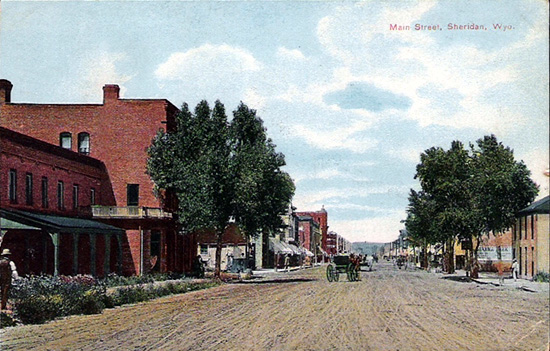
Main Street, looking North toward intersection of Main and Works, prior to 1908.
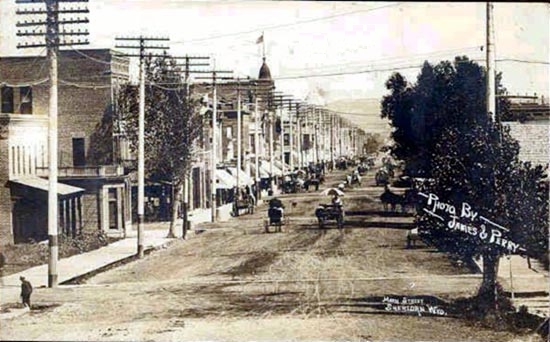
Main Street, looking North toward intersection of Main and Works, 1908. Photo by
James and Perry.
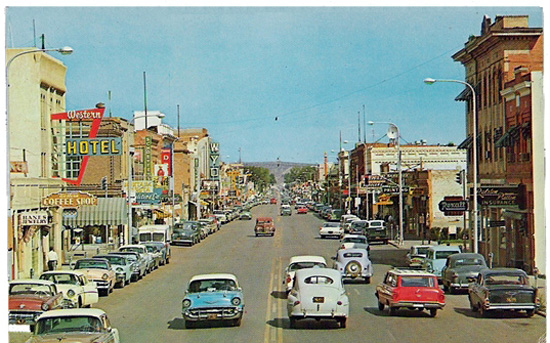
Main Street, looking North toward intersection of Main and Works, approx. 1970.
Many of the streets in the original section of town were named by Loucks for other early
settlers. Works Street is named after James Works, an early cattle drover.
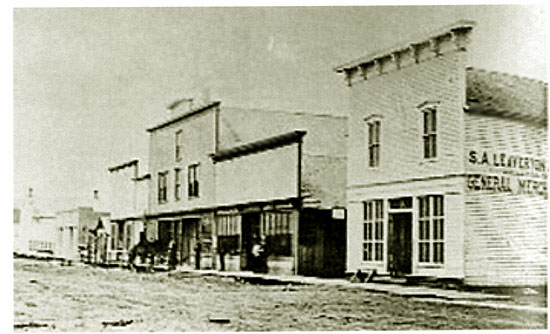
West side of lower Main Street, approx. 1890. Photo taken from intersection of Main Street and
Brundage.
The building on the right is Samuel A. Leaverton's General Mercantile. The Masonic Lodge met
in the second story. Post office was located in the store on the first floor. The three-story building, located
where the Wyo Theatre is presently situated, was Coffeen's Hall. The Hall was located upstairs and a
grocery was downstairs. To its left was C. W. Garbutt's grocery. Compare with the next photo of the same location taken in
1909.
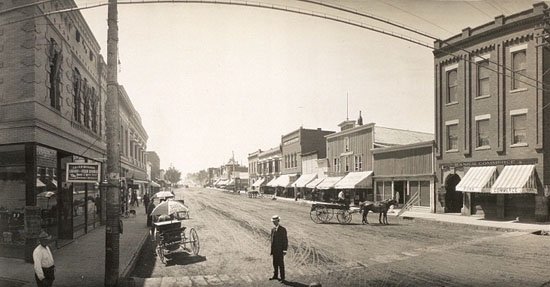
Lower Main Street, 1909, looking south from Brundage. Photo by F. J. Bardholtz.
In the photo, Leaverton's store has been replaced by the Bank of Commerce at 50 N. Main. The building also housed the
Masonic Temple. By the time the railroad arrived, the town had five fraternal orders as well as a
Grand Army of the Republic post. The building on the left is the Diefenderfer and
Dinwiddie Hardware Store. Before moving to their new lodge building in 1910, the Elks met on the second floor.
Next Page, Sheridan Continued.Main Street continued.
|